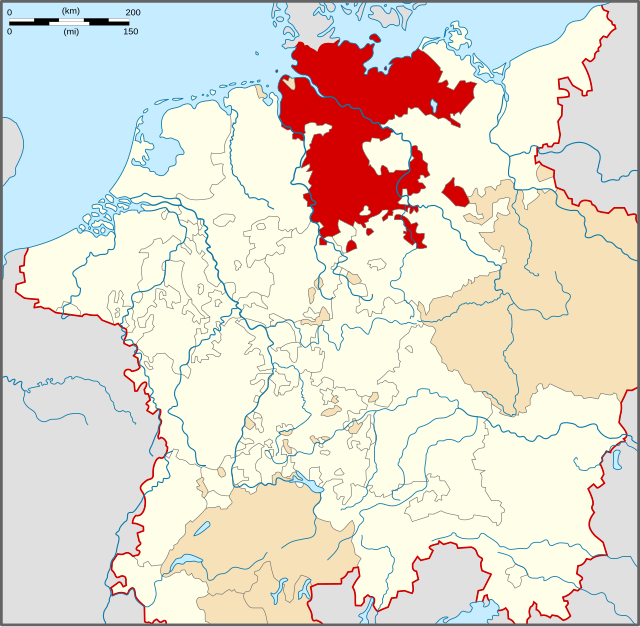| Name |
Type of entity |
Comments |
|---|
 Bremen Bremen |
Duchy |
Archbishopric of Bremen established in 787 by Charlemagne, secularized in 1648 as fief of Sweden, ceded to Great Britain in 1715; 12th seat to the Reichstag |
 Bremen Bremen |
Imperial City |
8th Rhenish City from 1186 |
 Brunswick-Calenberg Brunswick-Calenberg |
Duchy |
Subdivision of Brunswick-Lüneburg from 1494, united with Celle in 1705 to form Hanover, 34th seat to the Reichstag |
 Brunswick-Celle Brunswick-Celle |
Duchy |
Subdivision of Brunswick-Lüneburg from 1269 until 1705, 32th seat to the Reichstag |
 Brunswick-Grubenhagen Brunswick-Grubenhagen |
Duchy |
Subdivision of Brunswick-Lüneburg from 1291 until 1596, 36th seat to the Reichstag |
 Brunswick-Wolfenbüttel Brunswick-Wolfenbüttel |
Duchy |
Subdivision of Brunswick-Lüneburg from 1269, included Blankenburg, became Duchy of Brunswick after Napoleon, 38th seat to the Reichstag |
 Gandersheim Gandersheim |
Imperial Abbacy |
Established in 852 by Duke Liudolf of Saxony, Immediacy confirmed by King Henry the Fowler in 919, contested by Brunswick-Wolfenbüttel, 18th Prelature of the Rhine |
 Goslar Goslar |
Imperial City |
From 1290 |
 Halberstadt Halberstadt |
Prince-Bishopric |
Established by Charlemagne in 804, secularized in 1648 as Principality of Halberstadt held by Brandenburg |
 Hamburg Hamburg |
Imperial City |
9th Rhenish City from 1189 |
 Hildesheim Hildesheim |
Prince-Bishopric |
Established in 815 by Louis the Pious; 27th seat to the Reichstag |
 Holstein Holstein |
Duchy |
Established in 1474, held by the Danish Royal House of Oldenburg, from 1648 residence in Glückstadt |
 Holstein-Gottorp Holstein-Gottorp |
Duchy |
Subdivision of Holstein from 1544 until 1773 |
 Lübeck Lübeck |
Prince-Bishopric |
Established in 1160 by Henry the Lion, 49th seat to the Reichstag |
 Lübeck Lübeck |
Imperial City |
3rd Rhenish City, from 1226 |
 Magdeburg Magdeburg |
Prince-Archbishopric
Duchy |
Established in 955 by Otto I as Archbishopric of Magdeburg, secularized in 1680, held by Brandenburg |
 Mecklenburg-Schwerin Mecklenburg-Schwerin |
Duchy |
Established in 1352 |
 Mecklenburg-Güstrow Mecklenburg-Güstrow |
Duchy |
Subdivision of Mecklenburg-Schwerin from 1520 until 1552, again from 1621 until 1695 |
 Mecklenburg-Strelitz Mecklenburg-Strelitz |
Duchy |
Subdivision of Mecklenburg-Schwerin from 1701 |
 Mühlhausen Mühlhausen |
Imperial City |
From 1251 |
 Nordhausen Nordhausen |
Imperial City |
From 1220 |
 Rantzau Rantzau |
County |
Established in 1650, held by the Danish Royal House of Oldenburg from 1734 |
 Ratzeburg Ratzeburg |
Prince-Bishopric |
Established in 1154 by Henry the Lion, secularized in 1648 as Principality of Ratzeburg, held by the Dukes of Mecklenburg, Mecklenburg-Strelitz from 1701 |
 Regenstein Regenstein |
County |
From about 1160, united with Blankenburg in 1368, held by the Dukes of Brunswick-Wolfenbüttel from 1599 |
 Saxe-Lauenburg Saxe-Lauenburg |
Duchy |
Established in 1296, in 1689 fell to the Dukes of Brunswick-Calenberg, 66th seat to the Reichstag |
 Schwerin Schwerin |
Prince-Bishopric |
Established in 1154 by Henry the Lion, residence at Bützow from 1239, secularized in 1648 as a principality held by the Dukes of Mecklenburg-Schwerin |
